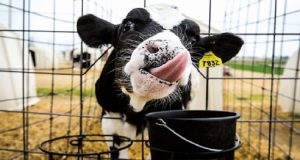Introduction
Lameness is the second most expensive illness of cattle farms after mastitis, which severely affects the
economic performance of the unit. Each case of lameness causes a decrease in the production of about
320 kg of milk in each milking period and can account for a high percentage of the forced removals of
the herd. Lack of copper in cows causes hoof cracking, abscesses and hoof infection. A high level of
selenium in animal feed causes lameness and changes in the shape of the hoof. In conditions where the
pH of the rumen decreases and becomes acidic, the possibility of lameness increases. In general, cows
with lameness show weak signs of estrus, of course, the negative effects can be minimized with the
correct pick hoof and with appropriate intervals, as well as timely treatment of infectious hoof. In the
herds that have problems with cows hoof, after proper pick hoof, in addition to improving reproductive
conditions, the amount of cattle feed increases and the amount of cow milk production increases.
An article published in The Journal of Dairy Science reports that lameness causes animals to consume less
feed and may even reduce milk production by up to 6 pounds per day. When the ambient temperature is
lower than 77 degrees Fahrenheit, the cows are in good condition. As the temperature and relative
humidity of the environment increases, animals are exposed to higher levels of heat stress. Even at low
levels of heat stress, animals begin to squirm in order to dissipate heat from the body. In such a situation,
a condition known as “respiratory alkalosis” will occur. In this situation, cows ruminate less and release
more saliva, on the other hand, in order to maintain the proper acid-base balance, cows increase the
amount of bicarbonate excreted by urine, which may cause acidosis (the cause of lameness). Also, the
standing time of cows in heat stress conditions is longer because in the standing position, the cooling of
the body is done more successfully than in the lying position. But in any case, unfortunately, long periods
of standing will lead to the occurrence of hoof problems in livestock and eventually lameness. To prevent
such problems, most importantly, we should try to minimize heat stress by providing a cool, comfortable,
well-ventilated environment with adequate access to water. Also, by using sufficient amounts of
potassium and sodium in the diet, animals will be able to improve the acid-base status by maintaining the
buffering capacity of the rumen and blood. Dr. Charles Guard (Dr. Charles Guard) from Cornell University
says that when cows stand on concrete, “there is a lot of pressure on certain parts of the head of the paw
and may lead to vascular lesions such as bleeding or necrosis. When standing, if the hoof is not arranged
correctly, this local pressure will cause more damage to the hoof.
Total result
As mentioned above, long periods of standing, especially if the bed is made of concrete, have increased
the number of clinical cases of lameness. Adequate nutritional management and correct pick hoof in the
determined intervals are the key pillars to minimize the incidence of acidosis (lameness agent). Although
poor nutrition may contribute to lameness, it is not the only cause.






































